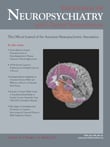To the Editor: Huntington’s disease is a disease with multiple CAG repeats and autosomal-dominant inheritance on chromosome 4p16.
1 There is still no effective treatment for this disease.
2 Moreover, patients with Huntington’s disease can be sensitive to psychotropic medications such as antipsychotic agents, including dopamine antagonists and serotonin-dopamine antagonists.
2 However, the use of nonpharmacological treatments might reduce the need for psychotropic drugs.
3 Here we present the case of a woman with Huntington’s disease who received nonpharmacological treatment in our day hospital.
Case Report
The patient was a 51-year-old woman with a history of good health and 9 years of education. She functioned well as an accounting assistant for 20 years. In recent years, she suffered from insomnia and had difficulty standing and balancing; in addition she experienced mild impairment in the activities of daily life. Assessment of her Mini-Mental State Examination (MMSE) was 16, and her Activities of Daily Life (ADL) score was 60. Chorea was also significantly present. Our neurologist diagnosed Huntington`s disease based on genetic test results. After the diagnosis was made, the patient experienced a severe major depressive episode accompanied by a suicide attempt. Sometimes the patient exhibited aggressive behaviors. Following combined therapy of an antidepressant and an antipsychotic agent, her mood gradually improved and the aggressive behaviors diminished. After 3 weeks of hospitalization, the patient was discharged in a stable mood.
The patient’s husband complained of her restlessness (akathisia) and irritability; moreover, he was concerned about side effects of her medications and asked us to change her prescription (risperidone, 2 mg/day, and lamotrigine, 100 mg/day). As the patient complained of dry mouth, body weight gain, and poor tolerance to the newer medication (olanzapine, 10 mg/day, and lamotrigine, 100 mg/day), we reverted to her previous regimen.
The patient’s husband continued to monitor her mental condition 24 hours a day. As we were anxious that he would experience burn out, we admitted the patient to our dementia day care unit (MMSE score =10 and Neuropsychiatric Inventory [NPI] score =64). Nonpharmacological treatments in the dementia day care unit included a well-designed schedule of behavior therapy, reminiscence therapy, and art therapy. After 2 months, her MMSE score remained the same and NPI was 21. Furthermore, the patient’s psychotropic medication was decreased to risperidone, 1 mg/day, and lamotrigine, 50 mg/day, with no obvious disturbing behaviors.

